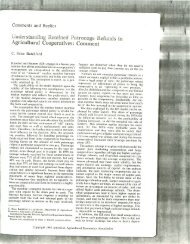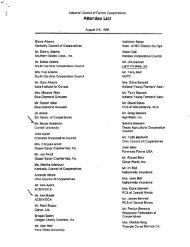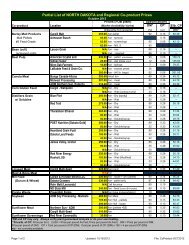Sunflower Production Field Guide - Your "Home Page"
Sunflower Production Field Guide - Your "Home Page"
Sunflower Production Field Guide - Your "Home Page"
You also want an ePaper? Increase the reach of your titles
YUMPU automatically turns print PDFs into web optimized ePapers that Google loves.
16<br />
Soil Water Management<br />
for Dryland Sunfl ower<br />
(Duane Berglund)<br />
Management practices that promote infi ltration of<br />
water in the soil and limit evaporation from the soil<br />
generally will be benefi cial for sunfl ower production<br />
in terms of available soil moisture. Leaving stubble<br />
during the winter to catch snow and minimum tillage<br />
are examples. Good weed control also conserves<br />
moisture for the crop. The use of post-applied and preemergence<br />
herbicides with no soil incorporation also<br />
conserves moisture when growing sunfl ower.<br />
Sunfl ower has the ability to exploit a large rooting<br />
volume for soil water. <strong>Field</strong>s for sunfl ower production<br />
should be selected from those with the greater waterholding<br />
capacity and soils without layers that may<br />
restrict roots. Water-holding capacity depends mainly<br />
on soil texture and soil depth. The loam, silt loam,<br />
clay loam and silty clay loam textures have the highest<br />
water-holding capacities. Water-holding capacity of<br />
the soils in any fi eld can be obtained from county soil<br />
survey information available from local Natural Resources<br />
Conservation Service (NRCS) USDA offi ces.<br />
Sampling or probing for available soil moisture before<br />
planting also can help select fi elds for sunfl ower<br />
production. With other factors being equal, fi elds with<br />
the most stored soil moisture will have potential for<br />
higher yields. Where surface runoff can be reduced<br />
or snow entrapment increased by tillage or residue<br />
management, increases in stored soil moisture should<br />
occur and be benefi cial to a deep-rooted crop such as<br />
sunfl ower.<br />
Irrigation Management<br />
(Tom Scherer)<br />
Irrigation of sunfl ower by commercial growers is not<br />
common, but sunfl ower will respond to irrigation.<br />
Data collected by the USDA Farm Service Agency<br />
(FSA) for irrigated crops in North Dakota shows that<br />
an annual average of about 1,500 acres of sunfl ower<br />
are irrigated each year. Data for irrigated and dryland<br />
oil-type variety trials between 1975 and 1994 from the<br />
Carrington Research Extension Center show an aver-<br />
age yield differential of about 500 pounds per acre.<br />
However, some years the irrigated trials yielded more<br />
than 1,500 pounds per acre more than the dryland<br />
plots, and some years the dryland plots actually had<br />
greater yield than the irrigated plots.<br />
Irrigated sunfl ower seasonal water use averages about<br />
19 inches. With good water management, average<br />
water use will increase from about 0.03 inch per day<br />
soon after emergence to more than 0.27 inch per day<br />
from head emergence to full seed head development.<br />
However, during July and August, water use on a hot,<br />
windy day can exceed 0.32 inch.<br />
Research by Stegman and Lemert of NDSU has<br />
demonstrated the yield potential of sunfl ower grown<br />
under optimum moisture conditions and the effect of<br />
water stress at different growth stages. Sunfl ower yield<br />
is most sensitive to moisture stress during the fl owering<br />
period (R-2 to R-5.9 reproductive stages) and least<br />
sensitive during the vegetative period (emergence to<br />
early bud). A 20 percent reduction of irrigation water<br />
application from plant emergence to the R-2 stage<br />
resulted in only a 5 percent reduction in yield, but a<br />
20 percent reduction in irrigation water application<br />
during the R-2 to R-5.9 period resulted in a 50 percent<br />
yield reduction.<br />
If soil water content is near fi eld capacity at planting,<br />
research indicates that the fi rst irrigation could be<br />
delayed until the root zone soil moisture is about 70<br />
percent depleted. However, if pumping capacity is low<br />
(less than 800 gallons per minute, or gpm, for a 128acre<br />
center pivot), a lesser depletion is advisable due<br />
to inadequate “catch-up capacity.” Irrigations during<br />
the critical bud to ray-petal appearance (R-2 to R-5.0)<br />
period should be scheduled to maintain a low soil<br />
moisture stress condition (35 percent to 40 percent<br />
depletion). Irrigation should be avoided from R-5.1<br />
to R-5.9 because of the susceptibility of the sunfl ower<br />
plant to head rot from Sclerotinia (white mold). Irrigate<br />
just before fl owering in the bud stages R-3 to<br />
R-4. Soil moisture depletion again can approach 70<br />
percent during late seed fi ll and beyond with little or<br />
no depression in yield.<br />
Yield increases due to irrigation depend on several<br />
factors. Soil water-holding capacity and precipitation<br />
are two of the most important. Research indicates that<br />
the seed yield versus crop water use (ET) exhibits a<br />
linear relationship with a slope averaging 190 pounds<br />
per acre-inch. This means every additional inch of







